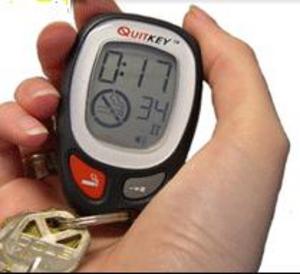I’ve tried a lot of different stuff to help me quit smoking. I’ve used nicotine gun, nicotine patches, and even the new prescription drug Chantix, but so far nothing has worked for me. Recently, I heard about a small electronic device called Quitkey that promises to help smokers kick the habit for good, and since my quit attempts have been unsuccessful so far, I figured I would pick one up and give it a try.
Quitkey is manufactured by a company in Virginia called PICS, Inc. and was developed with a grant from the National Institute of Heath (NIH). The concept behind Quit key is actually quite simple–after a brief ”sampling” period to learn your smoking habits, Quitkey will begin to prompt you when to smoke. Gradually, these prompts get farther and farther apart until eventually you are down to just one cigarette per day, at which point it should be easy to quit.
When I received Quitkey in the mail, I was impressed with the quality of the product packaging and the clarity of the instructions. Within a few minutes, I had Quitkey turned on and ready to go. For the first 7 days, all I had to do was press the ”smoke” button on the device each time I lit up a cigarette. This was not hard to remember and quickly became a habit. I liked the fact that each time I pressed the smoke button, the total number of cigarettes I had for the day was displayed. I was quickly able to see that I was smoking a far greater number of cigarettes each day than I had originally estimated.
When I woke up on Day 8 and turned on Quitkey, a short tune was played to let me know that the sampling process was over and the device would now prompt me with a series of beeps each time I was allowed to have a cigarette. The display also informed me that my Quitkey program would last 32 days, after which I should be smoke-free. On the first day, the device was prompting me to smoke a cigarette every 27 minutes, which I guess had been my average over the past 7 days. That’s a whole lot of cigarettes, and at first I found that there were times I didn’t even want to smoke when I heard the Quitkey prompt.
Very quickly, however, the time between each cigarette began to increase. Soon I was up to 1 hour between cigarettes, and not too much later it was closer to 90 minutes. I was definitely smoking less than I had been, there’s no doubt about that, but at the same time, Quitkey almost made smoking more important to me. Whereas before I would just light up when I had the urge for a cigarette without much thought, now I was holding this device, constantly checking it and counting down the minutes until I was “allowed” to have my next smoke. Quickly, my life started to revolve around Quitkey and impatiently waiting for it to prompt me to have a cigarette.
I kept using Quitkey for a little while longer, and eventually got down to the point where I was only smoking 6 cigarettes per day, which was a big improvement over the 40+ per day I had been smoking. However, Quitkey wanted me to keep going, and I wasn’t ready. It was already making me wait almost 3 hours between smokes, and it got to be too much for me. Soon, I started “cheating” by smoking when I wasn’t prompted to, and before long, I had given up on Quitkey altogether.
I think the big problem with Quitkey is that it never actually breaks your addiction to nicotine. From what I’ve read, even one cigarette a day is enough to keep you at least somewhat addicted to smoking-so in the end with Quitkey, you’re really just quitting cold turkey. Granted, it may be easier to stop smoking when you’re only smoking one cigarette per day as opposed to two packs. But with Quitkey, you’re left to deal with the nicotine withdrawal symptoms all on your own.
Most other smoking cessation methods, like the patch, the gum, and the prescriptions offer relief from the withdrawal symptoms that smokers experience while quitting. That’s really the whole reason why those products are successful. But with Quitkey, not only do you go through withdrawal without any help, but you seem to draw the process out way longer than it would be if you just quit cold turkey. I mean, I was down to 6 cigarettes per day with about 20 days lefts in the Quitkey program when I gave up, and towards the end I was downright miserable. I can only imagine the days where I only got to smoke two cigarettes, and then realizing I still had a week left. Not fun, if you ask me.
In the end, Quitkey did not work for me, although I didn’t stick with the program through the very end. It might be a good option for some people who don’t feel as “addicted” as I do, but I have a hunch that many other smokers would find the program just as difficult as I did. At first, the idea of quitting smoking by smoking is appealing to smokers, but if you’re really serious about quitting, I would recommend trying nicotine replacement therapy (i.e. the patch or gum) or a prescription first. Personally, I’m thinking about giving Chantix another try once my new health insurance kicks in. I’ll let everyone know how that goes…
(One last thing…although I wasn’t so impressed with Quitkey, I have been very impressed with a similar device from the same company which helps to cure insomnia. Click here to read my review of SleepKey, another electronic device available from PICS, Inc.)



